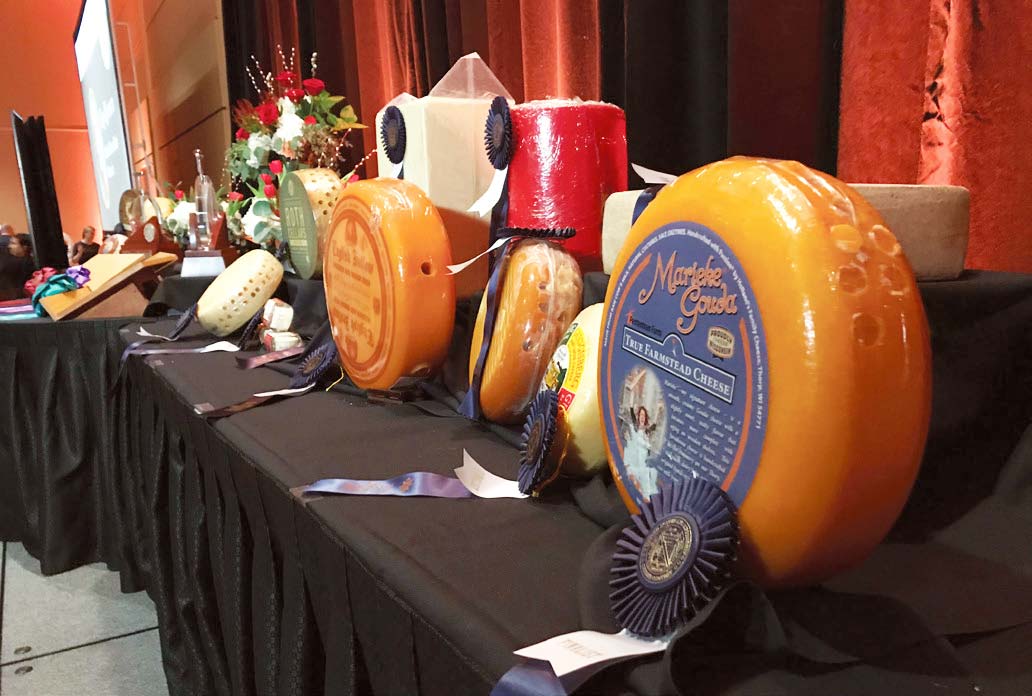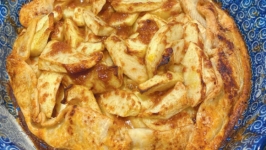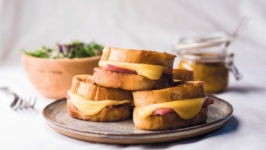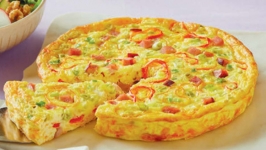Cheese Judging is a Tough Job but Someone has to do it
JIM MUELLER IS ONE OF THE COUNTRY'S BEST AT JUDGING CHEESE
The “judicial robe” – a knee-length white coat – calls to mind “doctor” rather than magistrate.
But when it comes to evaluating cheese, Wisconsin’s unofficial state food, either role symbolically suits Jim Mueller of Green Bay. As a certified cheese-contest judge, he’ll quickly diagnose what’s wrong with the chunks, blocks and spectacularly sculpted, 200-pound wheels on the table before him – and the severity of the problem. Then, like the courtroom judge, he’ll either make you pay for the shortcomings or make your day with a victorious outcome.
“I like to tell people I graded my first piece of cheese when I was 10 years old,” said Mueller, 66, whose father was a Swiss cheese maker in Monroe, the unofficial capital of America’s Dairyland. “The nice thing about judging cheese is it never talks back.”
The big two assignments in his field – the Super Bowl and World Cup, respectively, of the cheese industry – are the U.S. and world championships. Green Bay hosted the national competition in March at the Lambeau Field Atrium and the KI Convention Center downtown, while Madison is the permanent home of the global gathering.
The first thing that jumps out to a judge is, of course, the overall look of the entry, Mueller said – the curb appeal, if you will. In that sense, judges follow the same “procedure” at the outset as a shopper scouring the store shelves.
“We ask our judges to wear a buyer’s hat,” Mueller said. “We’re judging (partly) for marketability, so one of the first areas we look at is appearance. We’re looking for workmanship and uniformity in the presentation, (not) wrinkled packaging or irregular finishes.
“We’ll take that sample to a table, flip it over, turn it around, looking for any deducts.”
Then comes the all-important taste test.
The judges dig out a small helping with a plug, a cylindrical combination of knife and spoon. Then they bounce the sample around their inner mouths. As in a dog show, the ideal criteria varies by “breed”/type, the mozzarellas and goudas and Muensters and so on, each featuring a different set of ideal criteria.
“You’re starting to flavor it, but you’re also checking the body and texture,” Mueller said. “This is when you need to know the technical requirements, because some (varieties) you would want firm and some not so firm.”
The black checkmarks reveal themselves inside the knowing jaws of the judge. The mild cheddar, for example, can’t be too timid-tasting – or “weak and pasty” in Mueller’s words. Entries expected to pack a sharper kick must deliver on that promise of intensity, not fall flat.
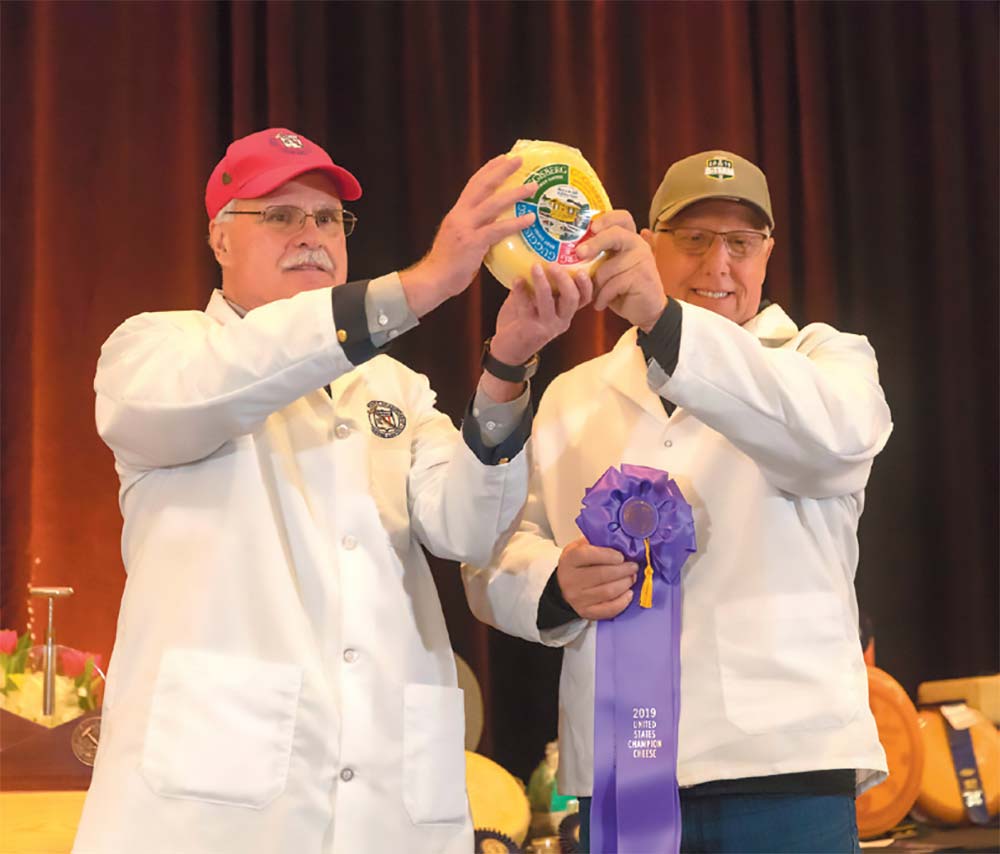 Chief Judge Jim Mueller (left) and 2019 U.S. Championship Cheese Contest winner Richard Guggisberg, Guggisberg Cheese. Photo courtesy of the Wisconsin Cheese Makers Association
Chief Judge Jim Mueller (left) and 2019 U.S. Championship Cheese Contest winner Richard Guggisberg, Guggisberg Cheese. Photo courtesy of the Wisconsin Cheese Makers Association
Another no-no, in most cases, would be “slits” or “eyes” brought on by excess bacteria that yield a “gassiness” of taste and feel Mueller said. However, with Swiss cheese, this quality would, of course, be a plus, giving the slices their signature holes and semi-oily surface complexion.
The readily identifiable characteristics of a particular cheese should neither be overdone nor underwhelming. Mueller cites the example of the increasingly popular pepper jack class, known for its hot sauce-like zest. “We always tell people who are entering to remember we are a cheese contest,” he said. “We want some cheese taste. If all we taste is black pepper, with no cheese profile or color, it’s a deduction.”
Speaking of which, since all cheese naturally comes out white – it's made from milk, after all – any orange or other added colorings must be evenly spread out from top to bottom, Mueller said. Cheese judges are both born and made, he said.
A food science degree or industry experience as a dairy researcher, buyer or grader – “the school of hard knocks” Mueller calls it – certainly qualifies one to weigh the merits of cheese, he said. Mueller himself is retired from a career in quality control, production and purchasing at a number of stops, including industry giants Kraft Foods, Schreiber Foods in Green Bay and Bel Brands.
But prospective judges are also naturally gifted with an enhanced sense of taste, not unlike a hound breed’s extraordinary nose.
“You need to perceive and pick up the four basic flavors of sweet, salt, acid and bitter,” he said. “Not everyone can. You can mock up some samples to see if you have that ability.”
But the food gods that giveth this innate ability can also taketh away, Mueller warns.
“You can be born with it, but you can kill it, too – like, for example, if you’re a heavy smoker, you can kill your ability to pick up bitterness,” he said. “You have to lead a good, clean life or you can dull those senses, those taste perceptors.”
As smoking has greatly declined over the past half-century, so has its performance-deflating side effects for cheese judges, Mueller said. But coffee, which remains popular in society, can do the same damage, so judges are asked to abstain from their Java before a contest.
The U.S. championships in February drew 2,555 entries from 35 states, divided into 116 classes. Mueller is paired with a second judge to furnish an average score of the 90 to 110 samples they examine each day.
The classes range from the age-old, common varieties to spreads, cheese made from sheep or goat milk, processed slices and a handful of all-around dairy products like yogurt and butter. Classes such as low-fat and low-sodium reflect the growing awareness of healthier alternatives in the dairy industry.
“You have to have a passion for cheese,” he said. “You’re going to be trying and evaluating a lot of it.”
Even the most devout cheese lover, however, could not consume that much without some gastro grief. Mueller said the judges simply chew on most of the samples or work them around the tongue, then discreetly spit them out. Inevitably some gets swallowed, though.
As in figure skating or gymnastics, every entrant starts with a perfect score – in this case, 100 – and then sees perfection whittled away by “defects” that can range from very slight and slight to “definite” and “pronounced.”
A score of 95 might mean you aced a high school math test, but at a cheese contest it indicates five “pronounced” problems each knocking off a full point. Winning scores for class champion or best in show are typically in the 98 to 99 range.
Mueller’s witnessed increased participation in the cheese-show world among small-batch, artisanal producers. A powerhouse in this category is Marieke Gouda of Thorp, Wis., a relatively small-sized operator that took overall second and third place at the February championships.
“(Owner Marieke Penterman) is a small operation in sales, but they have dialed in their make,” Mueller said. “She has her own farm, her own cows and controls the milk.
“(The artisan movement) is a rebirth, a throwback, to when years ago everyone was small. But you’ve had a lot of consolidation. (The larger processors) have their niches and produce the bulk of the cheese, but just like craft beer and wine we’re seeing all these unique flavors being entered by the small-batch producers.”
California may have overtaken Wisconsin in milk production in the last decade or so, but America’s Dairyland remains the king of U.S. cheese making – both in quantity and, in Mueller’s opinion, in quality. But like an able judge, he must set aside that bias in the ring along with any improper fondness for the Swiss variety he was raised with.
“It’s all just professionalism and leaving your personal preferences aside,” Mueller said. “But all good cheese starts with quality milk, and we have very skilled farmers here in Wisconsin, though the playing field is leveling out.”
BEST IN CLASS
AREA 'BEST IN CLASS' WINNERS AT THE UNITED STATES CHAMPIONSHIP CHEESE CONTEST HELD LAST MARCH IN GREEN BAY.
- Gorgonzola: Great Lakes Cheese, Seymour.
- Natural Rinded Cheese: Door Artisan Cheese, Egg Harbor.
- Mild Provolone: Agropur, Luxemburg.
- Aged Provolone: BelGioioso, Green Bay.
- Soft Cheeses: BelGioioso, Green Bay.
- Parmesan: BelGioioso, Green Bay.
- Flavored Cheeses w/Sweet Condiments: BelGioioso, Green Bay.
- Natural Snack Cheese: BelGioioso, Green Bay.
- Flavored String Cheese: Ponderosa Dairy, Kewaunee.
- Peppered Flavored Mild Heat: Arla Foods, Kaukauna.
- Flavored Butter: Pine River Dairy, Manitowoc.


